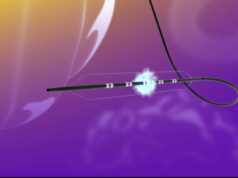On 21 January 2013, Gore announced it has received the CE mark for the new lower profile 31mm diameter trunk-ipsilateral leg and 32mm aortic extender components of the Gore Excluder AAA endoprosthesis for treatment of abdominal aortic aneurysms. The reduced profile allows the trunk-ipsilateral leg component to be used with an 18F Gore DrySeal sheath and allows the 32mm aortic extender component to be used with a 17F compatible sheath, making the Gore Excluder device one of the lowest profiles for treating aortic necks with an inner diameter of 27–29 mm. This key enhancement to the simple delivery of the Gore Excluder device, provides a reduced access vessel requirement (6.8mm) to physicians performing minimally invasive endovascular abdominal aortic aneurysm repair.
No changes have been made to the Gore Excluder device—instead, Gore has implemented an innovative process using ePTFE materials to constrain the device onto the catheter. In addition, a continued roll-out of lower profile Gore Excluder devices is planned. The future lowering of introducer sheath profiles exemplifies Gore’s commitment to improving patient safety while maintaining ease-of-use for the delivery of the Gore Excluder device. The 31mm trunk-ipsilateral leg endoprosthesis will only be available with the Gore C3 delivery system.
“To receive endovascular treatment for abdominal aortic aneurysm patients must meet certain vessel requirements which limits the patient population eligible for this minimally invasive alternative to open surgical repair,” said Paul Bachoo, consultant vascular surgeon, Aberdeen Royal Infirmary, Aberdeen, UK. “Gore’s lower profile 31mm trunk-ipsilateral makes endovascular treatment available to more patients while maintaining ease of use for physicians and long-term conformability.”
The Gore Excluder AAA Endoprosthesis is an endovascular stent graft that seals off the aneurysm and creates a new path for blood flow. The device is inserted through a small incision in the patient’s leg using a catheter-based delivery technique. Once the physician has positioned the graft in the diseased aorta, the Gore C3 delivery system uniquely and intuitively enables repositioning of the stent-graft. The ability to reposition the device may minimise complications that could occur if the graft needs to be moved after the initial deployment.
“Gore is committed to designing innovative devices that allow more patients to benefit from minimally invasive endovascular repair,” said Ryan Takeuchi, Gore Aortic Business Leader. “Lowering Gore’s access profiles expands the selection of product sizes and options available to physicians while maintaining ease-of-use for delivery that allows them to deliver the best possible patient care.”













